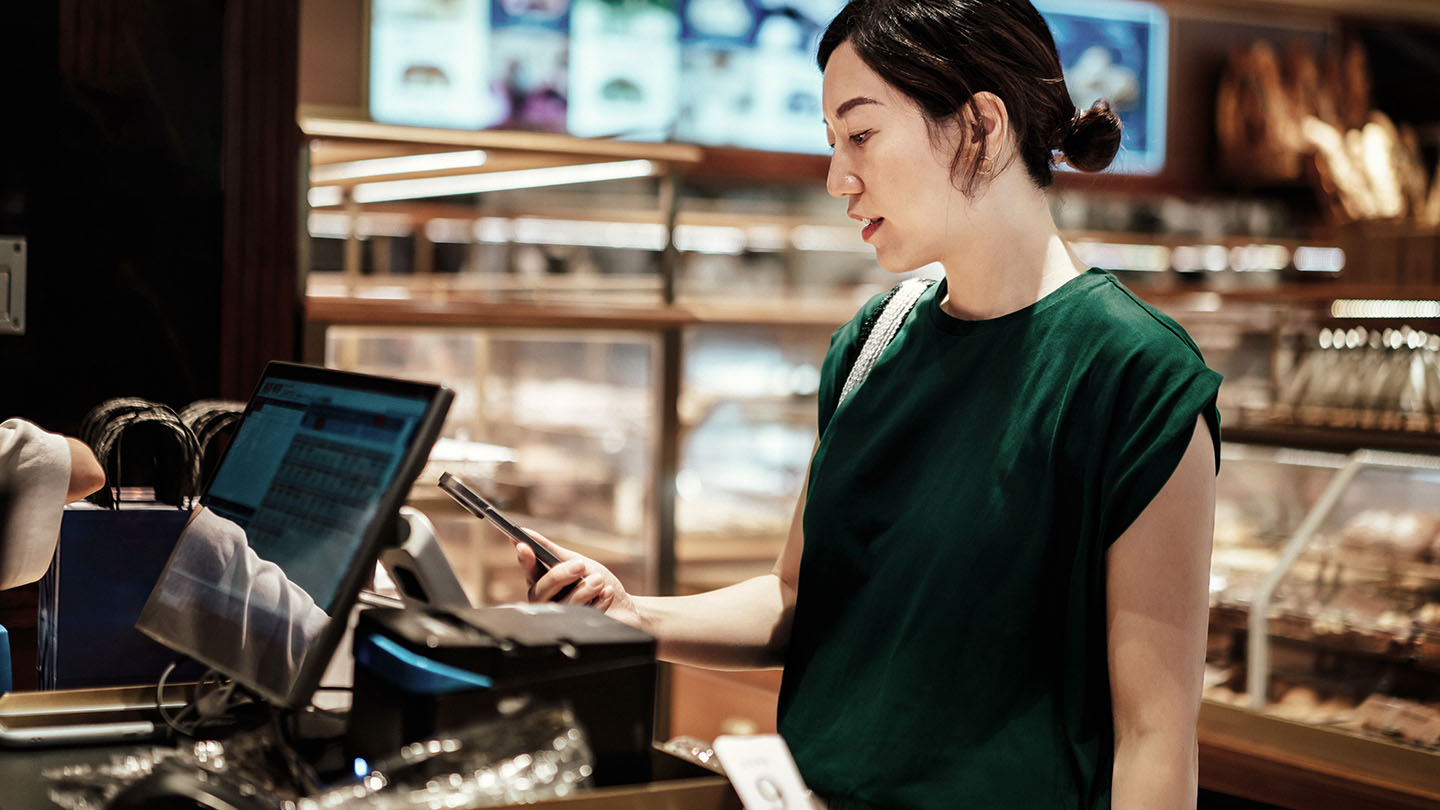
- The demand for immediacy driven by ubiquitous mobile adoption is rapidly changing how we search and buy.
- A growing expectation for rapid fulfillment and the increasing popularity of the digital marketplace requires merchants to rethink traditional supply chain models.
- Inevitably faced with constant digital disruption, investing in a frictionless payments model with a partner who understands the landscape is critical.
Mobile technology adoption “Innovation is moving at a scarily fast pace.” So said Bill Gates several years ago.1 Never have those words been truer than today when used to describe this new economic era of on-demand and convenience-driven commerce. We are witnessing a tectonic shift in how distributors distribute goods, how merchants sell those goods and how consumers consume them.
Today the point of sale is no longer just a checkout counter. The spread of digital payment methods means the new POS can be a smart phone, TV or watch; a retail kiosk or even an embedded sensor in a refrigerator or thermostat. As they experience instant gratification from one merchant, consumers begin to expect the same from all providers.
Across industries and geography, businesses are struggling to adapt. Innovations in digital commerce, including web- and mobile app-based technology and electronic payment methods, are fueling a dizzying array of capabilities to match supply and demand and enabling alternative payment methods.
By necessity, payment acceptance strategies are moving to the forefront of business model considerations, affecting operating issues that go beyond cash flow and working capital forecasting. In this new economy, payments systems inform and influence IT capability requirements, website and physical store design, marketing strategies and more.
Ready or not
Influential tech writer Michael Malone has crafted several “Rules of Technology.” His third law is:
“Every technology breakthrough takes twice as long as we expected and half as long as we are prepared for.” 2
With respect to the adoption of mobile payment technologies, many merchants are waiting for adoption to happen before they take it seriously. Their mindset is, “I’ll believe it when I see it.”
Malone’s theorem suggests that if you don’t start preparing soon enough, you won’t be ready when the technology does become pervasive. In the case of mobile payment technologies, merchants should understand that they’ll see it when they believe it—and make the investments necessary to fuel adoption.
At the heart of the on-demand movement: mobile devices
The number of mobile device users globally has reached five billion in just a few short decades, a remarkable growth trajectory.3 With a screen tap or swipe, connected customers can experience expertly curated offerings and finely tailored transactions on a “right now” basis.
Sales statistics prove the importance of convenience as a competitive advantage. In the US, mobile devices are estimated to account for 27 percent of all retail ecommerce sales in 2018, up from 19 percent in 2014. These sales have an average order total between $101 and $118, twice as much as orders by individuals not transacting on mobile devices.4
Further proof: Google reports that searches for “open now” have tripled in two years, but searches for “store hours” have dropped. Similarly, searches for “tonight” and “today” (such as “flights today” or “hotels tonight”) have grown 150% on mobile over the past two years.5
For these consumers, paying the premiums charged by on-demand apps and services is an easy tradeoff for taking the time to travel to a brick and mortar location and wait in line or spend time on the phone talking to a live CSR.
In the US, the transaction value (amounts paid by consumers) related to the on-demand economy totaled an estimated $57 billion in 2017.6 Businesses are fast realizing that they need a new rulebook. Conventional supply chains cannot compete in an on-demand world where fast, low-cost delivery is table stakes.
Reimagining business models
Regardless of industry category, whether established business or startup, companies are examining their current or planned operating model and, consequently, payments model, from on-demand points of view. Build, buy or partner strategies must all be considered for their various pros and cons.
Again, Amazon is a leader in pushing the build envelope. In addition to its initial business of managing the supply of the products they sell, the company developed a pure marketplace extension, in which it has no inventory risk whatsoever. Marketplace-maker examples proliferate today: Uber, of course, but also companies like PaintZen; UpCounsel; TaskRabbit or Angie’s List and many more.
Even healthcare is seeing dramatic changes in service delivery. In Boston, Uberdoc gives patients direct access to local specialists in select areas with no waiting period for a fixed fee of $300 a service especially welcomed in a city with an estimated waiting time of 52.4 days for a specialist appointment.7
Grocery, often considered the last bastion of traditional business models, is also breaking its own mold. For example, two-day delivery and click-and-collect in-store strategies are responding to consumers’ demand for convenience. If such expansion can’t be accomplished in- house, Costco, Aldi, Target and many other local, regional and national chains are demonstrating the success of partnering with delivery services such as Instacart to deliver within two hours.
For some major players, buy is the answer to reinventing or expanding their model and staying competitive. Walmart now owns Bonobos and Shoes.com, for instance. Target acquired Shipt to offer a personal shopper and home delivery capability to their customers. And, Amazon’s acquisition of Whole Foods portends even greater upset for the food industry in the near future.
Seamless payment systems should be at the top of the list
Plastic and cash have dominated commerce for decades. On-demand commerce is changing that quickly. The value of global digital payment transactions is projected to reach $4.6 trillion USD by 2021.8 “Frictionless” payments, such as QR or Near Field Communication (NFC) are destined to become backbones of the new economy.
“Just Walk Out Technology,” that tracks shoppers’ product purchases via their mobile phone is in the news in the US due to Amazon and Starbucks experiments with checkout register-less brick and mortar stores. But, in China, Alipay already has a million merchants accepting QR code payments. Parent Alibaba facilitates Alipay transactions by its 520 million users who first store their credit card and/or bank account details in their Alipay wallet. Readers will recognize the model as similar to PayPal’s.9
A key reason that digitized payments fuel the on-demand movement is that they enable merchants to store purchase preference and frequency information then offer personalized product suggestions, discounts or reward points or other offers, all building brand loyalty and revenue potential. This practice of “dynamic” or “contextual” pricing is becoming a key monetization strategy.
With appropriate data collection and analysis, price elasticity can be based on peak online periods or other criteria. In the case of subscription-based services for example, monthly or annual commitments can morph into micro-transactions, charged on a unit basis.10
The importance and power of personal data collection is just beginning to be understood in the US. And this year, the EU will launch General Data Protection Regulation (GDPR), legislation that will surely have a global impact on how marketers collect, analyze and use personal data. Stay tuned.
The battle for detailed transaction data
Captured data from third-party payment processors (total transaction amount plus the date, time and place of purchase) is, of course, extremely valuable in and of itself. It is item-level data, however, that presents the next battleground. Item-level purchase data are essential to tracking the consumer preferences that drive behavior and consequently enable merchants to design and target effective loyalty programs and incentive promotions.
Amazon and Google have both introduced proprietary methods of payment so that they would have access to this level of data. In another example, Daimler AG’s acquisition of Luxembourg-based electronic payment services provider PayCash in early 2017 was a key milestone in the car-maker’s launch of a dedicated electronic payment services provider under the “Mercedes Pay” brand name. We may anticipate more movement toward such proprietary payment systems because few merchants have been willing to let the proverbial fox into their hen house.
It’s important to note that the broader context of the data issue may present yet another dilemma for both merchants and processors: No clear “owner” of this data has been defined. Is it the seller, the manufacturer, the method of payment, the card issuer or the consumer?
All industries are vulnerable to disruption
We’ve all heard the term. “Disruption” in business is defined as the set of risks established firms face. In this fast-growing on-demand economy, it looks increasingly as if no business is immune. As noted professor Arun Sundararajan of New York University’s Stern School of Business says, “No matter how far away your industry seems to be from digital, there’s a digital disruption on the horizon.”11 But “evolution” might be a better, more positive, descriptor to apply to the transformation we are experiencing. After all, what is wrong with making consumer products and services more efficient and convenient?
How to navigate the complexity of establishing and maintaining seamless connection with your customers is critical. My caution to businesses, including startups, wanting to capitalize on the new era of consumer purchase habits is to find advisors who intimately understand customer purchase behavior and have the experience and the data to back it up. Such partners are key to helping you build out your model globally, with seamless payment acceptance across all available channels and geographic boundaries. With the right partner absorbing the many complexities of on-demand commerce, you may finally have the opportunity to mind your own business.
References
Friedman, Ura, “Bill Gates: ‘The Idea That Innovation Is Slowing Down Is…Stupid,” The Atlantic, March 12, 2014
Malone, Michael S., “Malone’s Laws of Technology,” ABC News, July 17, 2009
Weiss, Todd R., “5 Billion People Now Subscribe to Mobile Services Around the World,” eWeek, June 20, 2017
Shukairy, Ayat, “Mobile Commerce Statistics and Trends,” Invesp, accessed at https://www.invespcro.com/blog/mobile-commerce/
Solis, Brian, “Impatience Is A Virtue: How The On-Demand Economy Is Making Mobile Consumers Impatient, Forbes, November 20, 2017
Paine, James, “$57 Billion Dollar Opportunity: The State of the On Demand Economy in 2017,” Inc., https://www.inc.com/james-paine/5-stats-to-know-about-the-on-demand-economy.html
Smith, Hallie, “This App Wants to Make It Easier and Faster to Get a Doctor’s Appointment,” Boston, April 24, 2017
Yeo, Isabel, “How frictionless payments are changing consumers’ lifestyle,” Asean Today, October 23, 2017
Ibid.
Tamturk, Venus, “E-Commerce: What happened in 2017 & What’ Next in 2018,” CMSConnected, December 4, 2017
“The On Demand Economy,” SAGE Business Researcher







